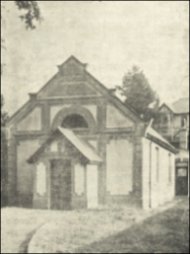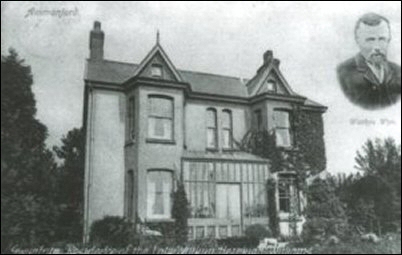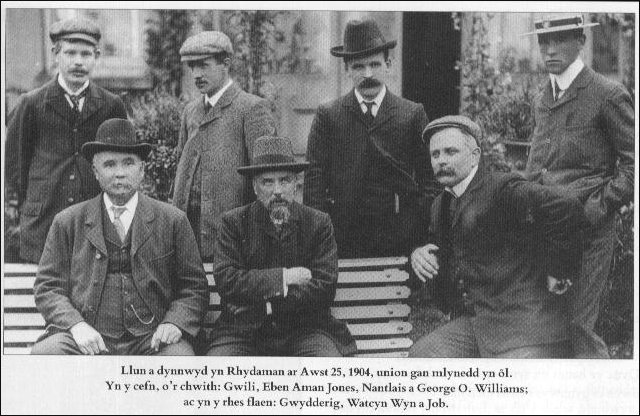EDUCATION IN AMMANFORD
GWYNFRYN SCHOOL
COLLEGE STREET
On the 6th of March 1880, the famous Watcyn Wyn opened his 'college' in the Ivorites Hall in Cross Inn, and this was a new beginning in education in the region. Two Independent preachers were the first teachers of the "Hope Academy" as the school was called, with Watcyn Wyn himself as assistant teacher, and P. R. Williams the headmaster. In July 1888, the school was moved to Gwynfryn, [the street was later named 'College Street' after the school] and Gwynfryn school or Watcyn Wyn's school it was always called from then on. Before this final move, the school was held for a while in the old building used as a barn by Mr Brodie, Brynmawr – the same building in which the 'British School' had been held. Here, Watcyn Wyn's influence was strong until his death in 1905.
English Baptist Church in Brynmawr Lane was originally Watcyn Wyn's school, 'The Hope Academy, which was the original 'college' of College Street. Watcyn Wyn built his home, called Gwynfryn, in a field next door. Watcyn Wyn's home, Gwynfryn, on College Street, Ammanford. The school closed in 1915 on the opening of Amman Valley County School (later renamed the Grammar School). On its closure Gwynfryn and its extensive grounds were bought by Evan Evans, 'Evans the Chemist' as his private residence. It was he who built the buildings on Ammanford Square in 1899; the Arcade in 1910; and the Palace cinema, also in the Arcade, in 1914. The poet 'Gwili' (John Jenkins) began his work as a teacher in Gwynfryn in October 1897, and laboured hard there until he went to Oxford in 1905. He returned to the school in January 1909 as headmaster of the school. Under his influence, the school revived amazingly, because in the meantime Watcyn Wyn had died in 1905 (but not before being able to deliver the inaugural sermon at the newly opened Gwynfryn Congregationalist Chapel on College Street in 1904). Still, time was short for the school, because the war came, and the school closed in 1915 due to the lack of students.
Photo: Watcyn Wyn (middle of front row) in 1904 with a gathering of poets and teachers at Gwynfryn. His son George O. Williams, who became the first headmaster of Amman Valley Grammar School in 1914, is top row, far right. Local Methodist minister and poet Nantlais is top row, third from left. A biography of Nantlais can be found in the 'People' section of this website, or click HERE. Poet John Jenkins (Gwili) who became Watcyn Wyn's successor as headmaster of Gwynfryn is first left, top row. Gwili can be found in the item on Edward Thomas in the 'People' section, or click HERE. The text below the photo reads: "Picture taken in Ammanford on August 25th 1904, a hundred years ago. In the back, from left: Gwili, Eben Aman Jones, Nantlais and George O. Williams; and in the front row: Gwydderig [Richard Williams], Watcyn Wyn and [J. T.] Job." (Photo from Summer 2004 edition of 'Barddas'). Gwynfryn school was not a small acquisition to thinking boys and girls of the region, and they took advantage of it to acquire a superior education before the days of the intermediate (ie secondary) school. Quite naturally most of the members were young preachers, this, perhaps, explains why so many preachers (of all denominations) were raised in the parish and surrounding area. The influence of the school was strong in them all – there was a Welsh atmosphere in the school from the beginning, and, of course, all the students tended to poetize under the glow of their master's Sun.
In September 1914, the county school was opened in buildings near Tir-y-dail, and Mr George O. Williams, B.A, was the first headmaster. He was a son of Watcyn Wyn, and he kept the traditions of his famous father alive in the new school, although it was children he had under his care. By 1928 there was a splendid new building for the county school near Bryn-mawr In January 1926, they opened an intermediate school in Ammanford — the first of its kind in the county, (Ammanford Secondary Modern) and on November 2nd 1935, a similar new school was opened in the village of Llandybie (Llandybie Secondary Modern).
Source: Hanes Plwyf Llandybie (History of the Parish of Llandybie) by Gomer Roberts, published 1939 (in Welsh) translated by Ivor Griffiths (1986)
A more detailed account of Gwynfryn school by Amman Valley born historian Huw Walters was published in Welsh in the South Wales Guardian, 23rd January 1975 which has been specially translated for this web site:
Gwynfyn School - by Huw Walters
The boys of Gwynfryn come, for sure,
From every part of Gwalia;
Americans are found here too,
And others from Australia.
And just a few at Watcyn's school
Are from far Patagonia.Thus declaimed Eos Dâr once from his poem to Gwynfryn School at a reunion of past students. After its inception in Ammanford in 1880, news of the school of Watcyn Wyn spread far, and it was not only from Wales that the students came, as the above poem shows.
.....Watcyn Wyn was a rustic, and a Welsh rustic at that. Although he had little education and no exceptional intellectual abilities, he founded a school, and he did more for the Welsh language in his day than did any grammar school or county school of that period.
.....English was the teaching language of every school and college in Wales at that time, and even such an 'enlightened' man as Sir John Morris Jones lectured on Welsh in English! But even more surprisingly English was also the language of the Denominational Colleges, although they were being maintained by Welsh churches and although it was to Welsh ministries that the students went after leaving college. Watcyn Wyn, in his small volume of 'Reminiscences', said of Carmarthen Presbyterian College:Only English, Latin, Greek and Hebrew were recognised at the college. Only dead languages lived there!
He found the whole business repugnant — 'it is an offence against our churches, an offence against our country, an offence against our religion and an offence against our language …' He further said:
The administration of education in Wales is still in the hands of strangers. It is not our ideas that are being realized, if we look about us and if we listen to the talk. How long this state of affairs will persist we can't be sure, but I believe this – so long as Welsh exists it should not be neglected so much in our education …
It is novel and unusual to come across such sentiments towards the end of the 19th century. Fair play to him, he realized the extent of the contempt for the language in school and college. Undoubtedly it was the lack of provision for education in Welsh that inspired Watcyn Wyn to establish a Welsh-language school of a thoroughly Welsh character. Only some twelve students were at Gwynfryn when it opened, but the headmaster could boast that some four hundred students passed through the school gates during his career as headmaster.
.....The school also became a focus of village life – did it not give 'College Street' to Ammanford? Some of the country's great men came to stay with the headmaster-poet at Gwynfryn, and many gifted people were invited to lecture to the students. There, Glasnant Jones saw men like Hwfa Môn, Gurnos, Cynonfardd, Dr Owen Evans, Sir Henry Jones, Llew Llwyfo, Michael D. Jones and others. These meetings were held every winter, and they became a means of awakening the interest of the students in culture.
.....But it was not only lecturing and preaching that took place there. Watcyn Wyn had a great interest in folk song, as his book Cân a Thelyn (Song and Harp) attests. Eos Dâr came to Gwynfryn with his harp, and also the local singer Madam Martha Harries-Phillips, who had been a member of Côr Mawr Caradog (Caradog's Great Choir). Many a 'Noson Lawen' was held under Gwynfryn's roof – poems were sung to harp accompaniment and 'englynion' were recited; there was great merriment and enjoyment. Dyfed, Gwydderig, J. T. Job and other chief bards of the nation came to visit the headmaster. Is it surprising that Job wrote the following of the school?For Gwalia's learning here's a tower strong,
Student's crystal palace,
Your Gwynfryn, blesséd poet,
South's Athens, without question.With one of the nation's most popular poets as their headmaster, it is no surprise that the students caught the competition bug. While studying at Gwynfryn men like Crwys and T. E. Nicholas won their first eisteddfod prizes. Other students were Llewelyn Williams, H. T. Jacob, Peter Hughes Griffiths, Penry Evans, Gwili and Tafwys.
.....Friday afternoon was an important period in the school timetable. With the aim of nurturing self-confidence in his students, Watcyn Wyn would hold a special class to hear the sermons of the prospective ministers:On Friday Gwynfryn's seats are full,
The afternoon is god-sent,
The tribes in file have all come home,
And all the lads are present.The headmaster would appraise every sermon, good or bad. 'But', said Crwys, 'what amused him most was the students' criticisms of their own sermons.' Friday afternoon at Gwynfryn was great fun, but Watcyn Wyn himself was taken by surprise one afternoon when one of the students took as his text 'It is a small thing to me that I should be judged by you.' And there was no adjudication on that occasion.
.....Three Gwynfryn students' reunions were held – in 1894 and 1901, and in 1944 on the National Eisteddfod field at Llandybie. T. E. Nicholas was probably the last old boy to die. The contribution of Watcyn Wyn and his school was a great one. The glory, unfortunately, has passed. [A biography of T. E. Nicholas can be found in the 'People' section of this website, click HERE.](Huw Walters, South Wales Guardian 23rd January 1975)
In 1972 an articlle was published in the Amman valley newspaper the South wales Guardian which gives us a tantalising glimpse into the long-vanished world of Gwynfryn and how the pupils were taught and housed in Ammanford during its time.
HE CHRISTENED CROSS INN RHYDAMMANBy The Right Honourable James Griffiths, Companion of Honour.
[from the South Wales Guardian, June 22nd 1972.]One of my earliest recollections is of the day when Watcyn Wyn returned triumphantly from the World Fair at Chicago. We marched from our school at Betws and set out for Cross Inn (renamed Ammanford in 1880) to join the throng of villagers, and I think that every person in the neighbourhood was in the procession as we carried the Bard to his home at Gwynfryn.
The Welsh community in the USA had organised a ‘Welsh National Eisteddfod' in connection with the World Fair – and OUR BARD, WATCYN WYN, had won the Chair prize. It was a notable triumph for a notable character.
TEULU'R DDOLGAMIn my estimation Watcyn Wyn was the greatest man nurtured in our valley. He belonged to a notable family from the upper reaches of the valley – the foothills of the Black Mountain. ‘Teulu'r Ddolgam' (see note 1 below) produced successive generations of gifted men. Contemporary with Watcyn Wyn as poets and preachers were his two cousins – Ben Davies of Panteg and T Mafanwy Davies, Solva.
I think all three were bardic winners at the National Eisteddfod. Their hymns are still sung – and some, like Watcyn Wyn's 'Rwyn Gweld o Bell y dydd yn dod (We see from afar the day to come) , have practically become national anthems.
Right down to recent days the ‘Ddolgam' tradition has survived – and when I was serving as a Miners' Agent, ‘Dai Ddolgam' was the leader of Brynhenllys Colliery, and one of my closest friends.
Watcyn Wyn – whose name was Watkin Hezekish Williams – was trained for the non-conformist Ministry. Alas, or fortunately, as some of us would say, he never had a "call” to a church. So he ventured to open an 'Academy' to train young men for the ministry at Ammanford. The 'Academy' was first-housed at the Christian Temple Vestry in 1880 until a new home was found at Gwynfryn, in what became the English Baptist Church in the same grounds. Watcyn also built the Gwynfryn House next to the English Baptist Church.
At first he had but few students, but eventually the Academy developed, and at its peak had some fifty to sixty students.
GIFTED
Though he was but a poor speaker (this accounted for his failure to have a 'call'), he had considerable influence as a teacher. Sir O. M. Edwards gives him a high place as a naturally gifted teacher, and all his students were influenced his persuasive personality.
In his biography, one of his students, H T Jacob Penie says: “I sat at the feet of greater scholars when I went from his Academy to College, but none of them had the genius of teaching which Watcyn had.”
VIVID GLIMPSE
The account given by the Rev. H T Jacob (“Atgofion H T Jacob”) paints a vivid picture of Watcyn Wyn and the Academy, and at the same time gives us a glimpse of our community when he lived at Cross Inn (as Ammanford was called until 1880) and was a student at the Academy.
PUPILS
H T Jacobs entered the Academy in 1885. The son of a blacksmith, he had in his youth already revealed the gifts of oratory which were to bring him to the greatest rank of pulpit orators in Wales.
Among his fellow students at the Academy was D M. Rees who was to spend his life serving as a missionary in Madagascar, and who was the first person I heard speak about Africa.
Then there were John Morgan Jones, Garnant, who became Principal of the Theological College at Bangor, and David Vaughan Thomas, who many think was the best composer in the Wales of his day and whose son, Wynford Vaughan Thomas, is famous as a broadcaster.
Watcyn Wyn would arrange suitable ‘lodgings' for his students. Jacob, and D. M. Rees lodged in Wind Street with David Evans, whose brothers, the Reverend Jonathan Evans and Evan Evans "Cheek", will both be remembered with affection.
SUNDAYS
Mr. Jacob tells us that the ‘standard terms' for lodging arranged by Watcyn Wyn were that two students were provided with a ‘study' and a bedroom for 2/6 each a week. They had to provide their own food – except potatoes, which were provided free – as well as laundry without charge.
The ‘fees' for tuition at the Academy were 25 shillings a quarter. The students were able to secure preaching engagements almost every Sunday. One of the best was at Gwynfe where the student was paid 7/6 for a Sunday, plus three meals at one of the farms houses. But this involved walking on the Sunday to Gwynfe and back! [Note Gwynfe is eleven miles from Ammanford.]
MINERS' LEADER
The Academy flourished in the days before secondary schools were available. It trained a host of preachers and many for other professions, including at least one miners' leader. For my colleague Johnny James Cwmgors, was proud to proclaim himself one of ‘Wat's boys'.
It was from Johnny that I heard stories of Watcyn Wyn's wit: “I have had to report on a visit by some of you to ______ Chapel last Sunday. They were disappointed, for they had announced as a preaching service what turned out to be a singing festival”. So Watcyn chided his budding preachers.
OLD COLLIER
Watcyn Wyn was an old collier, and like most old colliers he suffered from shortage of breath. One day, walking up the hill from Brynamman Station, he was compelled to halt by Gibea Chapel cemetery. A passer-by said: “Short of breath, brother?” “Yes”, replied Watcyn, “but there are men in there who would be grateful for what I have left”.
The one I like is the sad one. He was slowly and painfully dying of the ‘old malady' – ‘diffyg anadl' (see Note 2 below). His wife sustained life by giving him spoonfuls of a tonic. “That's right, my dear”, said Wat, “We'll keep on spooning to the end”.
A loveable man, a noble character, and the founder of our community. For when ‘Cross Inn' and Betws were joined together it was Watcyn Wyn who provided the name of our town: Rhydaman – Ammanford.
I am sure that you are, as I am, proud of our ‘founding father'.
____________________________________________________
Notes by Terry Norman
Note 1: T eulu'r Ddolgam (family of the Ddolgam. Y Ddolgam was the name of the farm Watcyn Wyn's mother came from in Cwmllynfell. It means literally the crooked field (dol = field; cam = crooked.)
Note 2: Diffyg anadl: shortage of breath (diffyg = lack; anadl = breath.)
END NOTE:
The provision of education in the Llandybie, Ammanford and Betws area has a long history, going back at least 270 years from the first circulating schools of Griffith Jones in 1731. This history is too long and detailed to be encompassed by one essay so it has had to be divided into several sections. And even this does scant justice to the rich and complex subject matter. It awaits a far more competent historian than the present author and will have to be far more scholarly than this patchwork quilt of a web site will allow. Still, we can but try. The various sections are:Education in Ammanford 1
Education in Ammanford 2
Amman Valley Grammar School from 1914 to the present
Amman Valley Grammar School – the beginnings
Betws Primary School
Ammanford Technical College
Gwynfryn College ('Watcyn Wyn's School')



